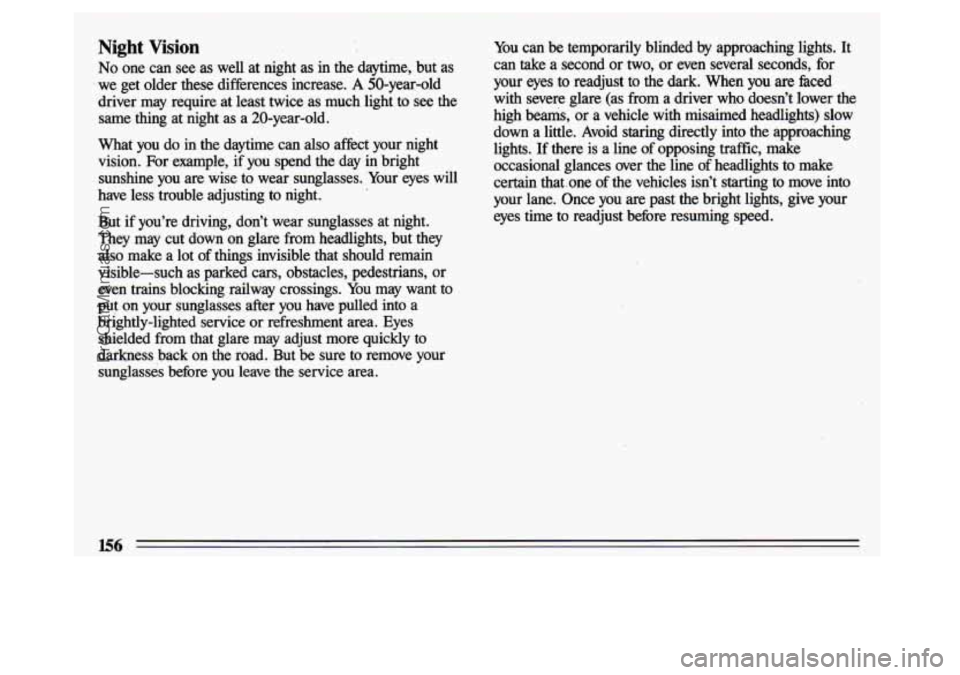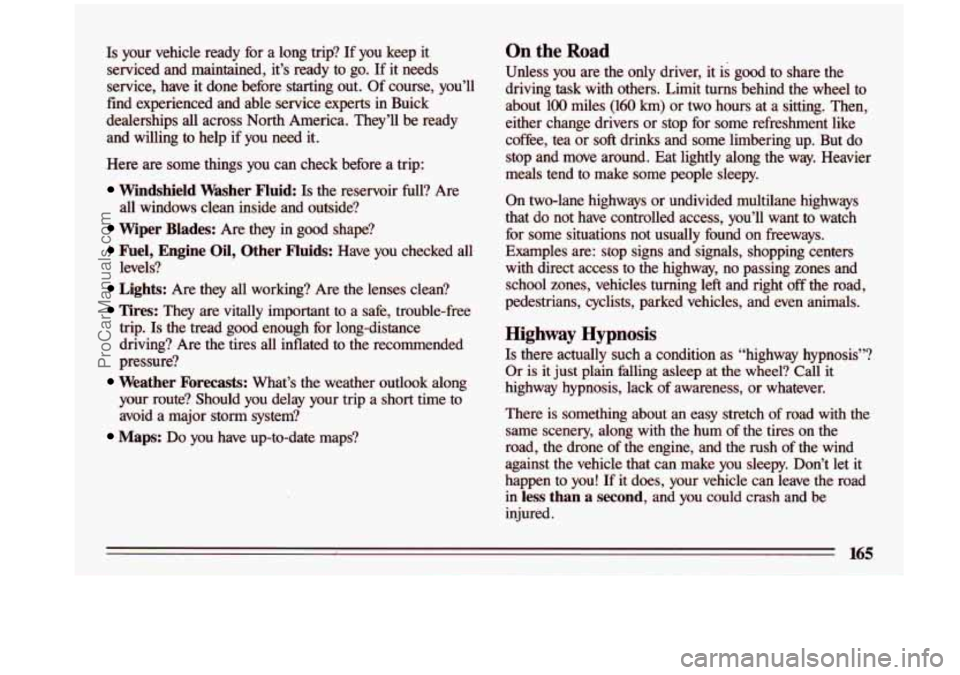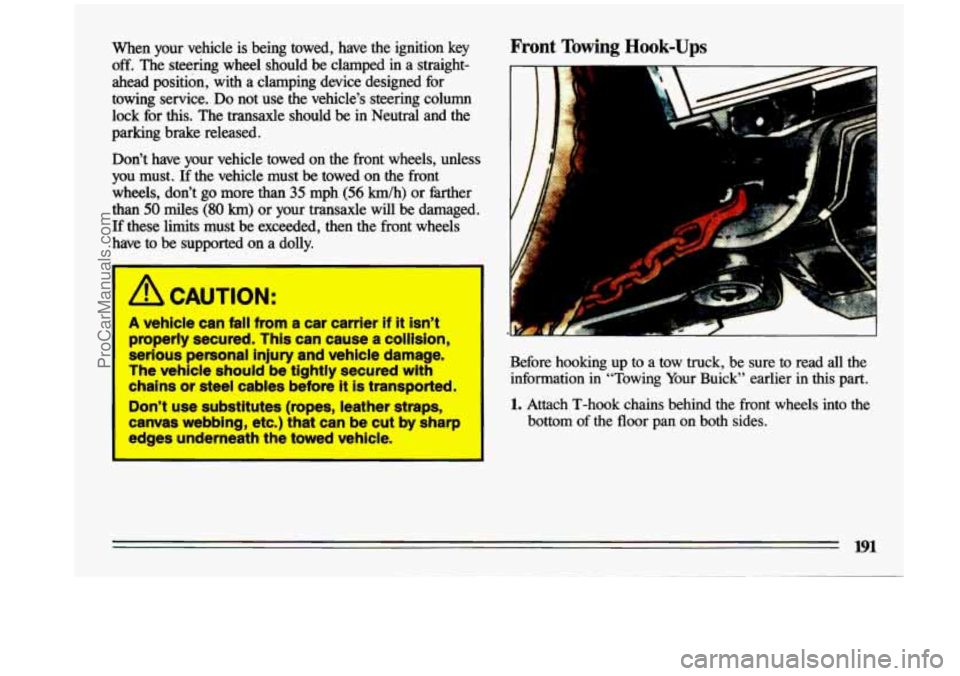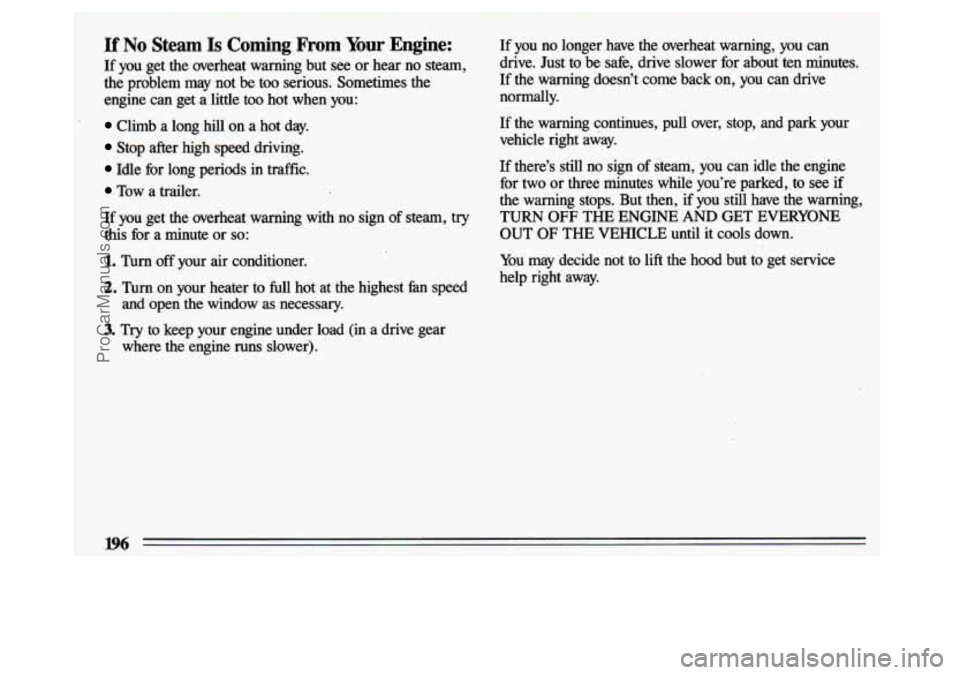Page 158 of 324

Night Vision
No one can see as well at night as in the daytime, but as
we get older these differences increase. A 50-year-old
driver may require at least twice as much light to
see the
same thing at night as a 20-year-old.
What you do in the daytime can also afkct your night
vision. For example, if you spend the day in bright
sunshine you are wise to wear sunglasses. Your eyes will
have less trouble adjusting to night.
But if you’re driving, don’t wear sunglasses at night.
They may cut down on glare from headlights, but they
also make a lot of things invisible that should remain
visible-such as parked cars, obstacles, pedestrians, or
even trains blocking railway crossings. You may want to
put on your sunglasses after you have pulled into a
brightly-lighted service or refreshment area. Eyes
shielded from that glare may adjust more quickly to
darkness back on the road. But be sure to remove your
sunglasses before you leave the service area.
You can be temporarily blinded by approaching lights. It
can take
a second or two, or even several seconds, for
your eyes to readjust to the dark. When you
are hced
with severe glare (as from a driver who doesn’t lower the \
high beams, or a vehicle with
misaimed headlights) slow
down a little. Avoid staring directly into the approaching
lights. If there
is a line of opposing traffic, make
occasional glances over the line of headlights to make
certain that. one of the vehicles isn’t starting to move
into
your lane. Once you are past the bright lights, give your
eyes time to readjust before resuming
speed.
156
ProCarManuals.com
Page 167 of 324

Is your vehicle ready for a long trip? If you keep it
serviced and maintained, it’s ready to go. If it needs
service, have it done before starting out.
Of course, you’ll
find experienced and able service experts in Buick
dealerships
all across North America. They’ll be ready
and willing to help if you need it.
Here are some things you can check before
a trip:
Windshield Washer Fluid: Is the reservoir full? Are
all windows clean inside and outside?
Wiper Blades: Are they in good shape?
hel, Engine Oil, Other Fluids: Have you checked all
Lights: Are they all working? Are the lenses clean?
Tires: They are vitally important to a safe, trouble-free
trip.
Is the tread good enough for long-distance
driving? Are the tires all inflated to the recommended
pressure?
Weather Forecasts: What’s the weather outlook along
your route? Should you delay your trip a short time to
avoid a major storm system?
levels?
Maps: Do you have up-to-date maps?
On the Road
Unless you
are the only driver, it is good to share the
driving task with others. Limit
turns behind the wheel to
about
100 miles (160 km) or two hours at a sitting. Then,
either change drivers or stop for some refreshment like
coffee, tea or
sol3 drinks and some limbering up. But do
stop and move around. Eat lightly along the way. Heavier
meals tend
to make some people sleepy.
On two-lane highways or undivided multilane highways
that do not have controlled access, you’ll want to watch for some situations not usually found on freeways.
Examples are: stop signs and signals, shopping centers
with direct access to the highway, no passing zones and school zones, vehicles turning left and right
off the road,
pedestrians, cyclists, parked vehicles, and even animals.
Highway Hypnosis
Is there actually such a condition as “highway hypnosis”?
Or is it just plain falling asleep at the .wheel? Call it
highway hypnosis, lack of awareness, or whatever.
There is something about an easy stretch
of road with the
same scenery, along with the hum
of the tires on the
road, the drone
of the engine, and the rush of the wind
against the vehicle that can make you sleepy. Don’t let it \
happen to you!
If it does, your vehicle can leave the road
in
less than a second, and you could crash and be
injured.
165
ProCarManuals.com
Page 183 of 324
Maintenance When Trailer Towing
Your vehicle will need service more often when you’re
pulling a trailer. See the Maintenance Schedule for more
on this. Things that are especially important in trailer
operation
are automatic transaxle fluid (don’t overfill),
engine oil, belt, cooling. system, and brake adjustment.
Each of these is covered in this manual, and the Index
‘will help you find them quickly.
If you’re trailering, it’s a
good idea to review these sections before you
start your trip.
Check periodically
to see that all hitch nuts and bolts are
tight.
181
ProCarManuals.com
Page 190 of 324
3'.
7. Don't let the other end touch metal. Connect it
to the positive (+)
terminal of the good
battery. Use a remote
positive
(+) terminal if
the vehicle has one.
8. Now connect the black negative
(-) cable to the
good battery's negative
(-) terminal.
Don't let the other end
touch anything until the
next step. The other end of
the negative cable
doesn't
go to the dead battery. It
goes to a heavy unpainted
metal part on the engine of
the vehicle with the dead
battery.
9. Attach the cable at least 18 inches (45 cm) away from
the dead battery, but not near engine parts that move.
The electrical connection is just
as good there, but
the chance
of sparks getting back to the battery is
much less.
10. Now start the vehicle with the good battery and run
U. Try to start the vehicle with the dead battery. the engine for a while.
If it won't start after a
few tries,
it probably needs
service.
ProCarManuals.com
Page 191 of 324
12. Remove the cables in reverse order to prevent
electrical shorting. Take care that they don't touch
each other or any other metal. Towing Your Buick
Try to have a GM dealer or a professional towing service
tow your Buick. The usual towing equipment is
a sling-
tvPe (A) or wheel-lift (B) or a car carrier (C) tow truck.
If your vehicle has been changed or modified since it was
fhctory-new by adding aftermarket items
like fog lamps,
aero skirting, or special tires and wheels, these
instructions and illustrations may not be correct.
Before
you do anything, turn on the hazard warning
flashers.
189
ProCarManuals.com
Page 192 of 324
When you call, tell the towing service:
That your vehicle has front-wheel drive.
The make, model, and year of your vehicle.
Whether you can still move the shift lever.
If there was an accident, what was damaged.
When the towing service arrives, let the tow operator
know that
this manual contains detailed towing
instructions and illustrations. The operator
may want to
see them.
-
/i CAUTION:
. To help avoid injury to you or othem:
Never let passengers rlde In a vehlcle that is
Never tow faster than safe or posted speeds.
Never tow with damaged parts not fully
Never get under your vehicle after it has
0 Always use separate safety chalns on each
@ Never use “J” hooks. Use T-hooks Instead.
being towed.
Secured:
been lifted by the tow truck.
side when towing
a vehlcle.
ProCarManuals.com
Page 193 of 324

when your vehicle is being towed, have the ignition key Front Towing Hook-Ups
off. The steering wheel should be clamped in a straight-
ahead position, with a clamping device designed for
towing service.
Do not use the vehicle’s steering column
lock for
this. The transaxle should be in Neutral and the
parking brake released.
I
Don’t have your vehicle towed on the front wheels, unless
you must. If the vehicle must be towed on the front
wheels, don’t go more than
35 mph (56 km/h) or farther
than
50 miles (80 km) or your transaxle will be damaged.
If these limits must be exceeded, then the front wheels
have
to be supported on a dolly.
1
I
&!, CAUTION:
A vehicle can fall from a car carrier if It Isn’t
properly secured.
This can cause a colllsion,
serious personal injury and vehicle damage.
The vehicle should be tightly secured with Before hooking up to a tow truck, be sure to read all the
chains or steel cables before it is transported. information in “Towing Your Buick” earlier in this part.
Don’t use substitutes (ropes, leather straps, I
1. Attach T-hook chains behind the front wheels into the
canvas webbing, etc.) that can be cut by sharp bottom of the floor pan on both sides.
edges underneath the towed vehicle. I
191
ProCarManuals.com
Page 198 of 324

If No Steam Is Coming From Your-Engine:
If you get the overheat warning but see or hear no steam,
the problem
may not be too serious. Sometimes the
engine can get a little too hot when you:
Climb a long hill on a hot day.
Stop after high speed driving.
Idle for long periods in traffic.
Tow a trailer.
If you get the overheat warning with
no sign of steam, try
this for a minute or so:
1. Turn off your air conditioner.
2. Turn on your heater to full hot at the highest fan speed
and open the window as necessary.
3. Try to keep your engine under load (in a drive gear
where the engine runs slower). If you no longer have the overheat warning, you can
drive. Just to be safe, drive slower for about ten minutes.
If the warning doesn’t come back on, you can drive
normally.
If the warning continues, pull over, stop, and park your
vehicle right away.
If there’s still no sign of steam, you can idle the engine\
for two or three minutes while you’re parked, to
see if
the warning stops. But then, if you still have the warning,
TURN OFF THE ENGRVE AND GET EVERYONE
OUT
OF THE VEHICLE until it cools down.
You may decide
not to lift the hood but to get service
help right away.
ProCarManuals.com